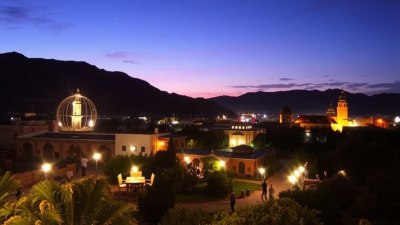The Power of Walking Through a Place That Hasn’t Changed for Centuries
Discover the timeless beauty and transformative experience of walking through places that have remained unchanged for centuries.

In an age where rapid technological advancements and urbanization dominate our lives, finding places that have remained unchanged for centuries can evoke a profound sense of nostalgia and connection to history. Walking through such timeless landscapes allows us to step back in time, offering a unique glimpse into the past. In this article, we will explore the power of walking in these unchanged places, examining their historical significance, emotional impact, and the lessons they impart to us in the modern world.
Historical Significance
Historically rich locations, such as ancient towns, rural villages, and centuries-old structures, act as time capsules that have preserved the stories of those who lived there. For instance, cities like Venice, Italy, or Bruges, Belgium, have maintained their medieval architectures and charm, providing a living narrative of their historical significance. These settings allow visitors to witness architectural styles, urban planning, and community life that have remained largely intact, creating a direct link to the past.
The significance of these places goes beyond architecture; they represent the cultures, traditions, and values of past societies. For many, walking through these areas invokes a powerful emotional response, making the past feel tangible and real. These places serve as reminders of the resilience of human history, the challenges faced, and the progress made over centuries.
Emotional Impact
Walking through a place that has not changed significantly can stir a wide range of emotions. The tranquility and simplicity of such locations can offer solace in our often chaotic modern lives. The familiar cobblestone streets of an ancient village or the serene views of a timeless landscape can evoke feelings of peace and reflection.
This journey into the past can also foster a sense of belonging and identity. When we visit or walk through places that our ancestors frequented, we feel an intrinsic connection to our roots. It allows us to appreciate the struggles and achievements of those who came before us, enriching our understanding of our own lives.
The Power of Nature in Timeless Spaces
Nature plays a significant role in these unchanged places, enhancing their allure. Landscapes that have been preserved over centuries remain largely untouched by human activity, offering glimpses of natural beauty in its purest state. From ancient forests to untouched coastlines, these natural settings serve as a reminder of the world as it once was, free from the encroachment of modernity.
Walking through these beautiful landscapes encourages mindfulness and a deeper connection with the environment. The sounds of rustling leaves, the scent of wildflowers, and the harmonious presence of wildlife draw us into a more conscious experience of our surroundings. In these moments, time seems to stand still, allowing us to embrace the beauty and tranquility of the natural world.
Lessons From the Past
There are invaluable lessons to be learned from exploring places that have not changed for centuries. One significant lesson is the importance of preservation. The existence of these places today serves as a model for maintaining cultural heritage and historical sites. They highlight the efforts needed to conserve our environments, architecture, and traditions amidst a rapidly evolving world.
Additionally, these sites demonstrate resilience. Many of them have withstood the test of time, weathering wars, natural disasters, and socio-economic changes. The endurance of these places reminds us of the robust spirit of humanity and the ability to adapt while remaining rooted in our identities.
Creating Meaningful Experiences
When we visit places that have retained their historical charm, we create lasting memories and meaningful experiences. The act of walking through such locales encourages us to engage in deeper reflection and contemplation, whether we are alone or accompanied by loved ones. The simplicity of exploring can enhance bonds and foster new connections.
Moreover, these experiences can inspire us creatively. The cultural richness and visual splendor of unchanged spaces can lead to artistic musings, writing, and storytelling. Being surrounded by history can ignite sparks of imagination, encouraging individuals to express their own understanding and interpretation of the human experience.
Challenges of Preservation
While the importance of visiting and preserving these timeless places cannot be overstated, challenges exist. Modern tourism often threatens the authenticity of these sites, as increased foot traffic can contribute to wear and tear. The delicate balance between encouraging tourism and maintaining the integrity of these environments is a constant challenge for municipalities and conservationists.
Effective management and thoughtful planning are crucial to ensure these areas remain accessible while preserving their historical authenticity. Educating visitors about the significance of these spaces and encouraging respectful exploration can also contribute to sustainable tourism practices.
The Joy of Exploration
For the adventurous traveler, walking through unchanged locations presents an opportunity for exploration that can lead to personal growth. Discovering off-the-beaten-path destinations invites us to step outside our comfort zones and experience the world through a different lens.
Every step taken in such a place is a reflection of both the past and the present, offering insights into our collective heritage. Engaging with local history, culture, and people along the way enriches our experience and fosters a broader understanding of the world we inhabit.
The Future and Our Connection to the Past
As we move further into the future, the interplay between modern life and our historical past becomes even more significant. Walking through places that have not changed for centuries reminds us of our responsibilities as custodians of these sites. By appreciating and preserving these treasures, we honor the past while nurturing our connection to it in a rapidly changing world.
In conclusion, the power of walking through a place that has not changed for centuries is an experience rich in history, beauty, and reflection. From the emotional responses evoked to the lessons to be learned, these journeys into the past enrich our lives and provide a deeper understanding of who we are. Let us embrace the opportunities to explore these unchanged places, appreciating the values they represent and the stories they tell for generations to come.











